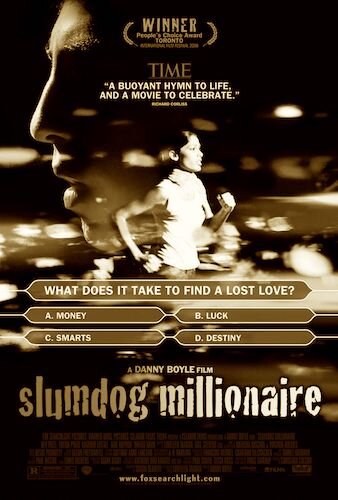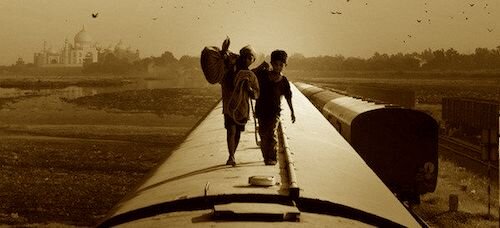Slumdog Millionaire
This review is a part of the Best Picture Project: a review of every single Academy Award winner for the Best Picture category. Slumdog Millionaire is the eighty first Best Picture winner at the 2008 Academy Awards.
Yes, I love Slumdog Millionaire.
Picture this: 2008. Who Wants to be a Millionaire? was still somewhat part of our consciousness. It wasn’t as hidden in the day time slots as it is now. For those of you that may be too young to know this, Who Wants to be a Millionaire? was a gigantic deal in the early 2000’s. It was the number one game show of game shows at the time, and easily the last mega game show that every household had to watch; it was of a dying breed. We needed to see who would will that million dollars. It could be anyone. It was all about the hot seat, and Regis Philbin asking if that is your final answer. There was definitely a time where this game show was more than relevant. It dominated conversations in locker rooms, at water coolers, and during car rides. Now, speaking to everyone else that remembers this, you may feel these memories flooding back to you.
Now, picture this: the film festival circuit was beginning to take on a new life of its own. Before, we knew what happened at Cannes or Sundance through newspaper reports and brief television snippets. Now, we had the internet to really soak in on these events from afar. The Toronto International Film Festival had new life breathed into it a number of years before, and was becoming the film festival of the general public. Finally, a film festival was about all of the cinephiles of the world, and not just the filmmaking elite or academics that had private access to these cinematic premieres. At other film festivals, there is a jury that elects the best film of each annual gathering (and other categories, of course). At TIFF, the public got to select their favourite film of festival.
Jamal on Kaun Banega Crorepati, the Indian version of Who Wants to be a Millionaire?.
Now, obviously Danny Boyle was a household name before 2008, with films like Trainspotting and 28 Days Later under his belt. At TIFF 2008, he premiered his then latest film Slumdog Millionaire: a film that was barely discussed. Maybe people went to go see it because it was the newest Boyle feature. Perhaps it was to see how Who Wants to be a Millionaire? could become the basis of a plot line. Well, the rest is history. It became a sleeper hit that blew into the stratosphere via TIFF, was crowned the Peoples’ Choice film at the festival, and was launched into Oscar contention. Ever since, the Peoples’ Choice winner at TIFF has either been nominated for Best Picture, or it has flat out won. The world finally paid more attention to this peculiar film.
I’m guessing that’s why Slumdog Millionaire is deemed overrated or a poorly aged Best Picture winner. For me, I think it’s fantastic. Here we have a mixture of Hollywood and Bollywood (note: this is NOT a Bollywood film by any stretch; it only is a tribute) about fate, and the dreams held onto by those in suffering. Jamal is on the biggest game show ever (well, back then anyway), but he may as well be in an interrogation room. Each question he is asked has less to do with him being one step closer to winning a fortune, and more to do with why someone from the lower class could possibly make it onto a stage this big. If anything, Jamal is literally brought in for questioning, because he is sought out as a cheater that couldn’t possibly know all of these answers.
Slumdog Millionaire uses Jamal’s poor upbringings as a means of showing the hardships of rural Mumbai.
Now, I usually don’t condone serendipity in film, especially if it’s too convenient. Given the fact that Slumdog Millionaire is connecting the cheesiest sides of Hollywood and Bollywood (the protagonist always wins, dreams come true, yada yada yada), I’m going to give the film a pass, because this is clearly a cinematic statement rather than a sign of laziness. Plus, isn’t the rest of the film basically stating what terrible luck Jamal has had up until now? The two influences are abundantly clear. With the Bollywood perspective, we have canted angles, a musical number to conclude the film, and the lack of romantic leads ever actually kissing (kissing on the lips used to be taboo in Bollywood films, and was rarely shown); a freeze frame cleverly blends both Hollywood and Bollywood together, since a kiss was about to take place, but doesn’t actually.
For the Hollywood side of things, we have the traditional safe ending, and the mood-setting music (A.R. Rahman does a sterling job of blending traditional Indian classical music with modern westernized sounds). The dynamic editing by Chris Dickens is another merge of both styles, with the pacing and focuses drawing from both sides of the spectrum. If anything, it’s clear how hard it is to separate either side entirely from Slumdog Millionaire, hence why it’s kind of of neither world at all. On the topic of convergence, the integration of Jamal’s life (and quest to find Latika) with Who Wants to be a Millionaire? is borderline hypnotic. We start off by darting backwards-and-forwards between game show questions and flash backs, but we arrive at a very symphonic climax, where the anxious ticking of the Millionaire clock becomes the heightening of a thrilling scene where lives could be lost. How could a film with this much clever use of its contexts be terrible?
Jamal uses Who Wants to be a Millionaire? to try and find Latika: a girl he grew up with and wants to protect for good.
One side of Slumdog Millionaire sees a rag-to-riches story. Another sees a young man who cares nothing about wealth, and instead uses a game show to alert a loved one and lure them to safety. You can complain about its probabilities and its schmaltz, but that’s absolutely what the film is trying to do. Through oversimplified visual media (Hollywood and Bollywood are guilty of this at times), Slumdog Millionaire addresses the shedding of excess wealth, the problems with overly capitalist or socialist societies (both sides of the spectrum are featured here to varying degrees), and the helping of loved ones in need. I do know that there is a hypocrisy here with a film that is infamous for its shooting controversies, including the housing situations of certain young actors, and the lack of acknowledgement for the amount of work Loveleen Tandan did as a co-director. I am only reviewing the film as it stands: a film. As a project worked on by many, there is a lot of problematic history worth researching.
At the end of the day, this small film reached major heights, propelling the careers of stars like Dev Patel and Freida Pinto, as well as behind-the-camera artists like A. R.Rahman (who has worked on a number of films since). I almost feel like Slumdog Millionaire is comparable to another previous Best Picture winner: The Last Emperor. Here are two westernized perspectives of other civilizations, with a heavy focus on aesthetics and a cinematic skew, which have sparked careers and shown sides of filmmakers that we didn’t know were there beforehand (first Bertolucci, now Boyle). The former film presents an ending society, and the latter focuses on an ongoing issue in societies around the world. Observing just the film by itself, I love Slumdog Millionaire and all of its fleeting dreams clashing with unsettling realities.
Andreas Babiolakis has a Masters degree in Film and Photography Preservation and Collections Management from Ryerson University, as well as a Bachelors degree in Cinema Studies from York University. His favourite times of year are the Criterion Collection flash sales and the annual Toronto International Film Festival.








